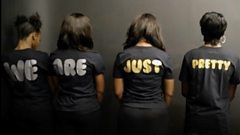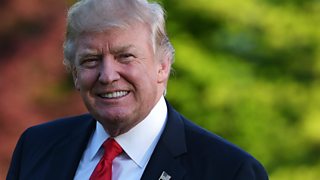Michelle Obama: 'Black Like Me'
By marrying a man with lighter skin, has the former first lady Michelle Obama changed how black women and girls see themselves?
In 2008, Valley Fontaine was watching the Democratic National Convention on television with a couple of girlfriends in a London pub, when she saw Michelle Obama for the first time. What struck Valley was not Michelle Obama’s words, but her looks – she was a darker-skinned woman married to a lighter-skinned man. In the world of entertainment, sports and celebrity culture, the trend is usually that black men pair with women who are lighter skinned, who have more European attributes.
The roots of these preferences are long standing. Right after abolition, African Americans in the United States used a barometer to admit lighter skinned people into certain institutions and clubs, excluding their darker skinned peers. Today, this prejudice – ‘colourism’ - lingers. For darker skinned black women, finding value and acceptance is often harder when it comes to all spectrums of life, from employment to dating. But could Michelle Obama’s powerful presence change colourism’s contradictions? Could she change the way darker-skinned black women and girls view beauty, power and access to opportunity in their own skin? Valley travelled to the US to explore the history of colourism, its persistence, and the ways it affects women’s lives today.
(Photo: US former first lady Michelle Obama December, 2016. Credit: Saul LoebAFP/Getty Images)
Last on
More episodes
Previous
Clips
-
![]()
'You're too dark'
Duration: 00:59
-
![]()
'Your skin looks dirty'
Duration: 01:25
-
![]()
'Cute for a Dark Skin'
Duration: 01:29
Broadcasts
- Sun 19 Feb 2017 03:06GMT�������� World Service except News Internet
- Sun 19 Feb 2017 14:06GMT�������� World Service except East and Southern Africa, News Internet & West and Central Africa
- Sun 19 Feb 2017 15:06GMT�������� World Service East and Southern Africa & West and Central Africa only
- Wed 22 Feb 2017 09:06GMT�������� World Service except Americas and the Caribbean & News Internet
- Wed 22 Feb 2017 12:06GMT�������� World Service Americas and the Caribbean
- Wed 22 Feb 2017 23:06GMT�������� World Service except News Internet
- Thu 23 Feb 2017 02:06GMT�������� World Service Australasia
Featured in...
![]()
President Trump: 100 Days—Trumped
The story so far...





